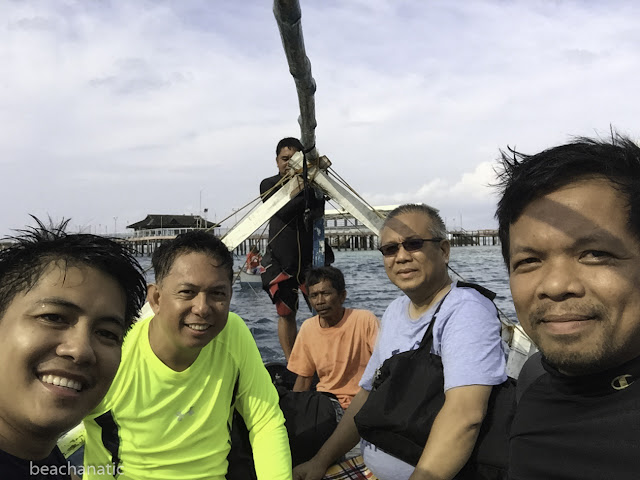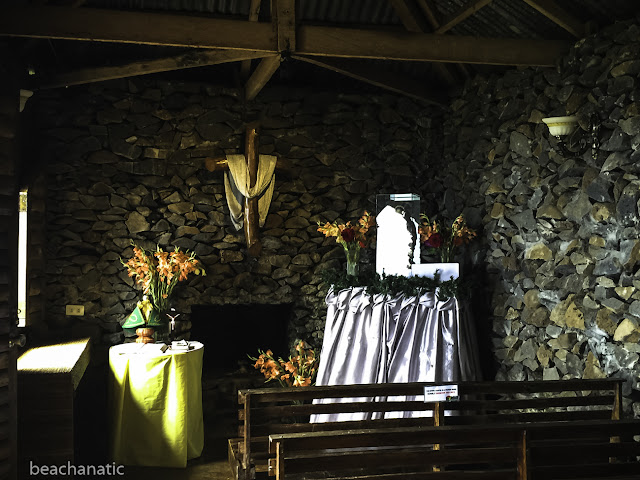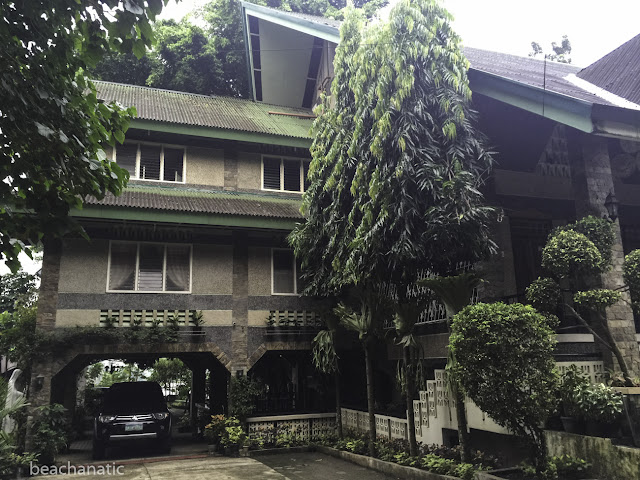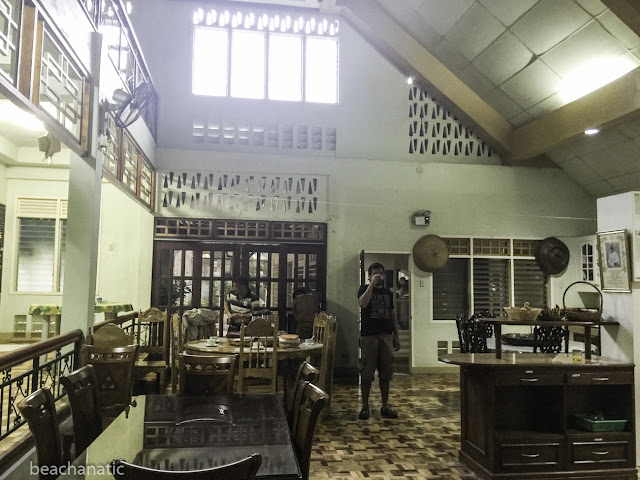When Cebu Pacific had a Piso sale,
I took the opportunity to buy tickets to Ozamiz which I have never been to yet.
Then I noticed in the map that the nearest airport from Ozamiz was Pagadian.
Since I have never been there yet also, I decided that I will fly back to
Manila from Pagadian, in that way, I will be able to go to two provinces in
just one trip: Misamis Occidental and Zamboanga del Sur. The ticket from
Pagadian to Manila was even cheaper than that of Ozamiz. Bought also
tickets for my friends Ronnie and Mark, whom I was sure would come along. We
were met at the airport by Julian, the driver of my classmate Msgr. Max Naron
who is the Vicar General of the Archdiocese of Ozamiz. When I texted Max
the week before that I will be visiting Ozamiz he assured me that I will have a
car and a driver-guide who will bring me to places I would like to go. From the
airport we went directly to the Archbishop’s residence where we were billeted.
Took breakfast and placed our things in our room. The second floor of the
residence has a good number of rooms as the priests would usually stay there
every Tuesday's. The bishop and the resident priests are staying downstairs.
Abp. Dosado was not there when we arrive as he was in Cebu for his
eye checkup. The first thing we noticed was the good number of doors at the
residence. Even just to go to the dining room from the lobby we had to
pass by at least three doors.
We
were told by Julian that Msgr. Max prepared for a beach outing as I requested.
So after breakfast we right away went for our short city tour so we could catch
up with Max. We first visited the cathedral. We also went up the choir loft to
look at the pipe organ that was recently repaired. By its size, I think this
would be biggest pipe organ outside of Manila. Aside from the keyboard near the
organ, another keyboard was placed near the altar where the choir now usually
sing. Met for a moment the parish priest who is also the diocesan
oeconomus.
We
made a short stop at the Gaisano mall to buy some shirts. Then we
went to the port where we visited the Cotta or Virgen sa Cotta which is a
shrine of the Immaculate Conception, the bas relief of which is
attached to the wall of the fort. It is like the outdoor shrine of Pilar in
Zamboanga. Known to be miraculous, the Cotta attracts several pilgrims every
day. The feast day of the Cotta is every July 16 which is the feast of the Our
Lady of Mt. Carmel. Our guide was saying that since the place is a public land
masses before were said not only by the Catholics but
also by the Aglipayans. Now, the Aglipayans just retained their donation box
which is situated at the entrance to the image of the Immaculate Conception,
while that of the Catholics is at the exit of the shrine.
Took
some pictures at the entrance of the fort just beside the Cotta which is called
Fuerte de la Concepcion y del Triunfo built in 1756.
 |
| Airport of Ozamiz. |
 |
| The chapel in the Archbishop's residence of Ozamiz. |
 |
| A hall at the second floor of the Archbishop's residence where priests usually gather every week. |
 |
| The garden at the Archbishop's Residence. |
 |
| One of the halls at the second floor of the residence. |
IMMACULATE CONCEPTION CATHEDRAL
Ozamis City, Misamis Occidental
Founded: 1811
 |
| The facade of the Cathedral of Ozamis |
 |
| Inside the Cathedral. |
 |
| The pipe organ of the Cathedral was newly repaired. It is said to be the second biggest pipe organ in the country. |
 |
| The pipes of the organ. |
 |
| The main keyboard. A smaller keyboard was also installed near the altar where the choir usually would stay. |
 |
| A tall statue of St. Augustine at the left side facing the Cathedral to commemorate the Agustinian recollects who were among the missionaries of Ozamis. |
 |
| The statue of St. Ignatius of Loyola on the right side facing the Cathedral in commemoration of the Jesuit missionaries who evangelized the place. |
 |
| The facade of the Cathedral with the statue of the Immaculate Conception below the pediment. |
 |
| The Shrine of the Virgen sa Cotta. |
 |
| The Shrine is part of the park just near the sea |
 |
| Many pilgrims would visit everyday the Shrine. |
 |
| A family praying before the image of the Virgen. |
 |
| Just beside the Cotta sa Virgen is this main entrance to the fort called Fuerte de la Concepcion y del Triunfo. |

From the cotta we went to
the parish of Msgr. Max in Tudela which is only 11 kilometers away from Ozamiz.
He was no longer at the convent when we arrived. So hurriedly we left for the
MOAP (Misamis Occidental Aquamarine Park), which was just in the next town of
Sinacaban where Max was already waiting for us. The MOAP has about 200 meters
of concrete walkway towards the sea where a restaurant is open at the end. Another
building nearby on the sea was also being constructed to serve as a hall. This
place was being operated by the provincial government. However our destination
was to an island or sandbar about a kilometer or two away from the mainland.
This was formerly called the Dolphin Island for until a year ago the place had
tamed dolphins which was open to the public for viewing and playing. The place
was closed due to a civil case filed against the investor. Apparently the place
was entrusted by the former governor to an investor who developed the place.
Conflict arose when the new governor who was an opposition no longer showed any
interest in the place. The former governor and the investor were brought to
court. While the case is pending the place was ordered closed by the court. The
province in the meantime administered the place. However since no support was
coming from the government the caretakers freed the remaining dolphins. Since
the caretakers of the place were friends of Max it was there that we were
brought. So we had the whole resort to ourselves that day. A small
engine boat with another paddle boat tied to the engine boat where our other
companions were, brought us to the place. Since it had to carry another boat
the speed was like that one paddling. The dolphin island is not really an
island but just a sandbar. In fact when we arrived, there was no sand to speak
of. The whole place was surrounded by water. It was only when we left as it was
getting low tide that the sand bar started to appear.
Had early lunch there and then went for snorkeling afterwards. We had two guides from the province for the snorkeling. We looked at the corals. There was a steady growth of soft corals at the concrete posts of the resort. Looked for the big groupers and snappers but we could not see them anymore. There were still 16 giant clams there. While we were eating we were regaled by spooky stories that the caretakers experienced while guarding the place at night. They said they would always hear some voices calling them in the evenings that would emanate from near the toilet and by the engine room. Once they said, they rescued a boat which capsized nearby. They brought the men to the resort, gave them some rice which they could cook at the other end of the resort. About past midnight these fishermen went to caretakers asking permission to leave as they could not sleep because of strange sounds that they could hear.
The weather was just lovely that day. It was cloudy but the sun would shine mildly from time to time which was perfect as we were not able to bring sunblock. It did rain for a while while we were swimming. But it stopped when we took the boat for our trip back to shore.
SAN ISIDRO LABRADOR PARISH CHURCH
Tudela, Misamis Occidental
Founded: 1938
 |
| Facade of the newly renovated church of Tudela. |
 |
| Inside the church of Tudela. |
Then we went to the town of
Jimenez to see the oldest church in the province of Misamis Occidental. The
ceilings still had geometric paintings. They also had a pipe organ. Went up the
belfry to see the old bells and the weights which is part of the old church
clock which recently stopped working because of a part that was stolen.
We also went to
the cemetery to see the centuries-old balete tree. From there we went back to
Ozamiz to the Archbishop’s residence. There was a heavy downpour as we were
going back.
Max came to join us for
dinner at the residence. Had some beer prior to supper at the lounging room at
the second floor where a billiards table was.
After breakfast we left the
Archbishop’s residence for our trip to Pagadian. Our first stop was the College
Seminary of Ozamiz, the St. John Paul College Seminary where they
keep the chair used by Pope John Paul in Manila when he came
for the World Youth Day.
Our next stop was the Hoyohoy
Highland Stone Chapel and Adventure Park in Hoyohoy, Tangub City. We rode on
the zip line which traverses the mountain belonging to Tangub and the other
mountain on Ozamiz. One way is 1.25 kilometers and going back is 1.1km at 850
meters in height. The zip line experience was uneventful. We enjoyed more the
buggy ride back to the first station. Over craggy rocks and sudden turns and
flights the buggy car maneuvered well.
We went next to the port in
Tangub where the proposed Panguil Bay Bridge will be built which will cross
over to Lanao. Visited the parish church of Tangub. Had a short break by the
church of Bonifacio where we bought some longkong lanzones and mangosteen.
Had lunch at a self-service
restaurant in Molave, Zamboanga del Sur. Then we went up to the
Eriberta Spring Resort in Brgy. Diwan, Molave, Zamboanga del Sur, about
5 kilometers from the town proper on an unpaved and rocky road. We took the
opportunity to take a short dip at the cold waters.
ST. MICHAEL THE ARCHANGEL PARISH CHURCH
Tangub City, Misamis Occidental
Founded: 1935
Upon reaching Pagadian we
first visited the cathedral. Went to the C3 and the
Gaisano Malls and rode their tricycle which is uniquely built as the passenger
seat is at an angle of almost 45 degrees. It was already evening
when we arrived at the Bishops residence where we were staying for the night.
Supper was ready. We met two of the priests who were staying at the residence.
The bishop was still out as he had an invitation. I noticed that one
of the priest was sick perhaps from a recent stroke. He still had an speech
impediment and his left hand was not that strong yet. While we were eating a
Nigerian priest of the Spiritans Order and assigned in Iligan joined us.
The bishops residence was
built by the bishop is such a way that it would be cool all the time. Hence
there are no aircons in the rooms. The windows had screens but with
bigger holes for the air to enter. Hence every bed had mosquito nets already in
place as they were already tacked at the end of the bed by tubular poles
surrounding the bed.
The following day, as I was
taking coffee before leaving for the airport I met Bp. Cabajar who
was also departing for Iligan for a Bishops-Ulama meeting. I met also their
vicar general and superintendent of catholic schools who is residing at the residence.
My flight was still at 9:20 am but Mark's and Ronnie's was at 7:20. I
joined them on the ride to the airport in the hope that my flight could be
changed so I could join them on the early flight. I was denied. However just
for consolation they transferred my seat which was already checked in online to
a better window seat near the front.
Since I still had time to
spare, with Julian we went back to the city for a short sightseeing. Went to a
lookout which had a beautiful view of the whole city of Pagadian. The building
though was under construction and we reached just the second floor as the tower
was closed. Then went to the city port and took some pictures of the
salted-fish market before going back to the airport.

































































































































No comments:
Post a Comment